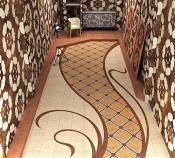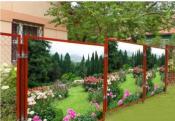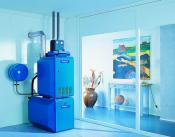Search
Login
Recommended
Sewerage of a country house
For the full life of a country house, as you know, light, heat and water are needed. But where to get the waste of human life? They solve this problem using autonomous sewers in various ways, in this article we will talk about the installation of autonomous sewers by professionals.
Content
- General information
- Sewerage inside the house
- The tightness of the house drain
- Forced sewage system
- Pipes for sewage inside the house
- Autonomous sewage system with soil treatment
- Installation of a septic tank video
- Complete biological wastewater treatment plant video
- External sewage pipes
General information
The country house includes a considerable sewage system inside the house.
This includes sewage from plumbing installations, sewer pipes from washing machines, dishwashers, etc.
All this is collected at the exit of the house into a single pipeline and is discharged out, as a result, all contaminated water flows into the treatment plant.
Sewage purified from coarse particles, in the future, gets into the drainage well, into aeration trenches, into storage tanks and other structures.
The choice of a treatment system depends on the geological studies of the site and on the type of sewer installed.
The entire autonomous sewer of country houses is made according to professional design documentation, it is developed and approved by supervisory authorities.
Sewerage inside the house
All main sewage inside the house is based on gravity.
All drains from toilets, bathtubs, sinks, household appliances enter the drain pipe, which is located on the floors of the house and is located almost in a horizontal position.
Then, all drains are sent to the sewer riser and then to the exhaust pipe, which connects through the inspection well to an external autonomous sewer installation or enters a centralized sewer network.
But the last option is not our case.
A vertical pipeline or riser also performs the ventilation function, the riser should rise above the roof of the house by about 0.5 meters - this drains the sewer gases into the atmosphere, thereby eliminating vacuum congestion.
Sometimes an unpleasant smell appears in the house, one of the reasons may be a malfunction of the riser, therefore, if there is no way to bring the riser out, it is necessary to use an air return valve.
For the free movement of drains by gravity, all horizontal pipes are laid with a slight slope, up to 4 degrees, the slope, of course, is directed to the external sewer installations.
All connections of house pipes are made using tees, bends, crosspieces, fittings, etc.
The tightness of the house drain
The intra-house sewer network, ideally, should have absolute tightness.
Oversight, when installing pipes is unacceptable, it is necessary to exclude not only smudges of the liquid, but also the exit of gases.
To prevent gas escapes, siphons are used (their operation is based on the principle of a water seal).
If sinks are used very rarely, a dry shutter siphon is installed.
If plumbing fixtures are installed far from the riser, siphon water seals complement the installation of anti-siphon air valves.
In order to exclude a counterflow of sewage drains (this happens when the sewage or flooding system fails during floods), a special ball valve or sewer valve is mounted in the pipeline - such a installation will prevent flooding of basements.
Forced sewage system
If the sewage system is arranged only on the basis of gravity drainage, this will not allow to drain sewage from the plumbing system located below the external pipeline - for example, waste disposal from the zero level.
In this case, use special pumping units.
Such installations are very compact, usually installed behind the toilet or under the sink.
In work, they showed their reliability, during installation - simplicity, they are convenient to maintain.
These toilet models have a non-return valve and a cutting mechanism, it crushes debris, thereby preventing congestion.
The pump unit has a carbon filter that absorbs unpleasant odors.
Pipes for sewage inside the house
Currently, for the internal pipeline network, polymer pipes are used in the installation.
Pipes made of sanitary polypropylene rightfully occupy a leading place, as they have shown reliability, efficiency, ease of installation.
Modern polypropylene pipes are not subject to corrosion, do not contribute to the deposition of dirt, are easily compiled according to the principle of a child’s designer, all parts are inserted into each other, if necessary, the pipe can be shortened (simply cut, form a chamfer on the cut) and connected to an adjacent pipe, cut the fittings not allowed.
Autonomous sewage system with soil treatment
The sewerage of a country house may look like an autonomous sewage station with soil post-treatment.
All the waste falls into the sump, in which all the heavy particles precipitate, this sediment is decomposed by anaerobic bacteria, these bacteria work on organic compounds without the presence of oxygen.
Further, these residues are pumped out with a certain frequency by the sewage machine, all of these waste products are finished, but the clarified water remains - they fall into the next compartment, here aerobic bacteria are taken for their cleaning, which can only work in the presence of oxygen.
In this compartment, special filters made of porous materials are used to increase useful microargonisms.
After this compartment, the water still needs further purification.
Cleaning options can be different if the soil is sandy, sandy loam or peat, you can do only with a filter well, and then the water is simply dumped onto the relief.
If the soil is clay or loamy, they dig trenches and build aeration fields, then the water is dumped onto the relief.
With this method of cleaning, it is necessary to comply with sanitary standards, such systems are in stable demand. Their main advantage is that they are non-volatile, simple, reliable, relatively inexpensive.
Installation of a septic tank
Here we will talk about installing a plastic tank - a sump in the form of a multi-section septic tank with a biological filter in the secondary compartment, in stages.
First stage: depending on the size of the settling tank, a pit is excavated for a sewer installation.
Second phase: the foundation pit is completely lined with geotextiles.
The third stage: a pillow of sand and gravel is poured at the bottom of the pit, a reinforcing bar structure is laid on it, then all this is poured with concrete, into which the elements of the septic tank fixture are embedded.
Fourth stage: with the help of a crane, a non-volatile biological waste water treatment plant is lowered into the pit.
The fifth stage: to prevent ascent of the septic tank during spring floods, the installation is fixed to a reinforced concrete slab.
Sixth stage: a pipe is installed for pumping precipitation, the pipe should go to the surface of the earth.
Seventh stage: the foundation pit falls asleep, the lid is laid on the pipe.
Complete biological wastewater treatment plant
Complete biological treatment occurs through aerobic wastewater treatment.
Such complexes are of two types: there is forced continuous technology or intermittent aeration.
Possible cleaning using chemical reagents.
In a continuous aeration system, with the help of a compressor, air is supplied to a special compartment - aeration tank, here oxygen enriched in a water suspension of activated sludge, an excess of activated sludge is obtained at the outlet, can be used as natural fertilizer and process water, which is discharged into a drainage well or in a trench .
For the correct operation of a deep biological treatment plant, a prerequisite is a constant supply of electricity.
If there is no electricity, then large problems begin with sewage.
Therefore, when installing such a system, it is necessary to stock up on autonomous power.
External sewage pipes
For the arrangement of external sewage, polypropylene pipes are also used, they can be either corrugated or smooth.
These products are resistant to chemical attack, non-corrosive, easy to install, etc.





